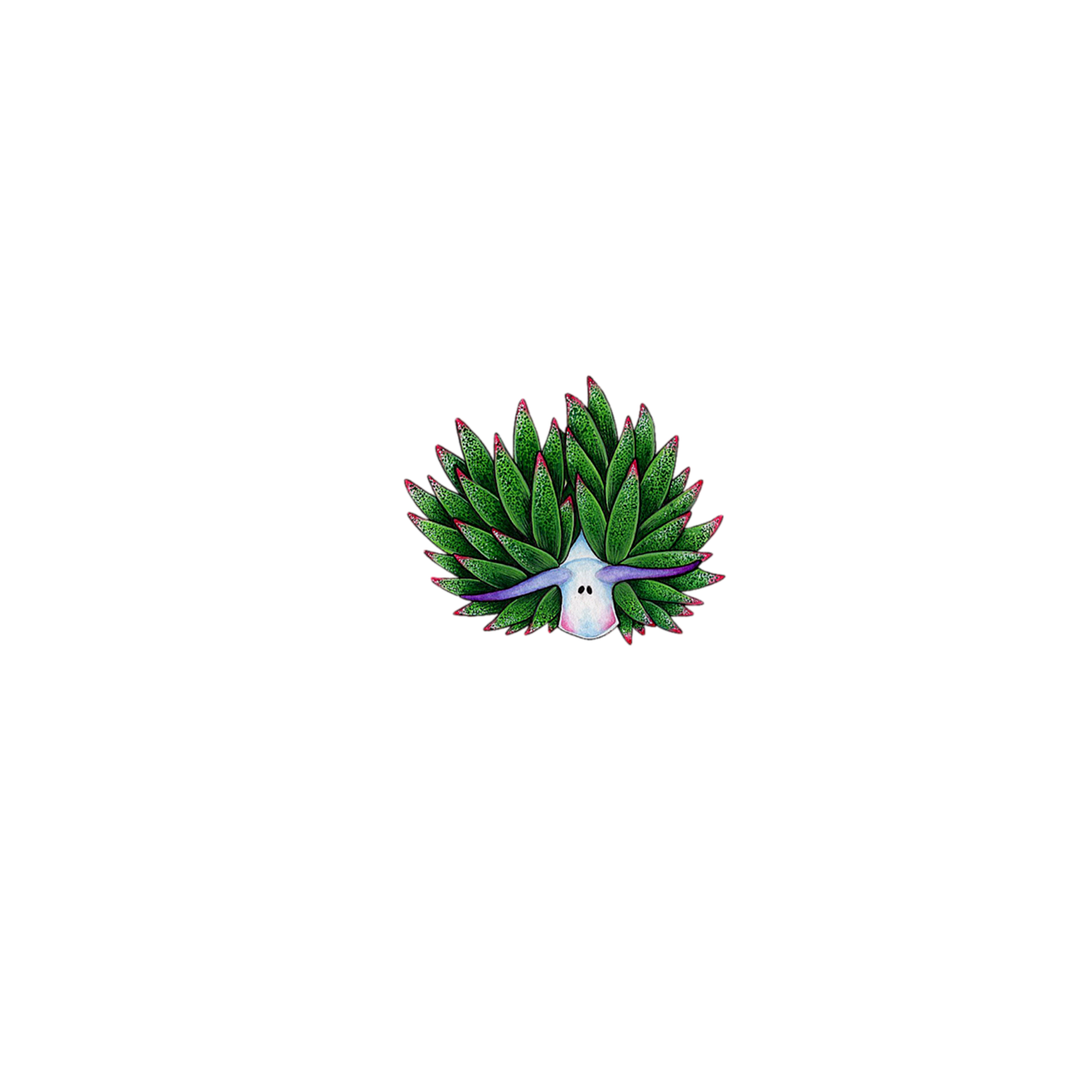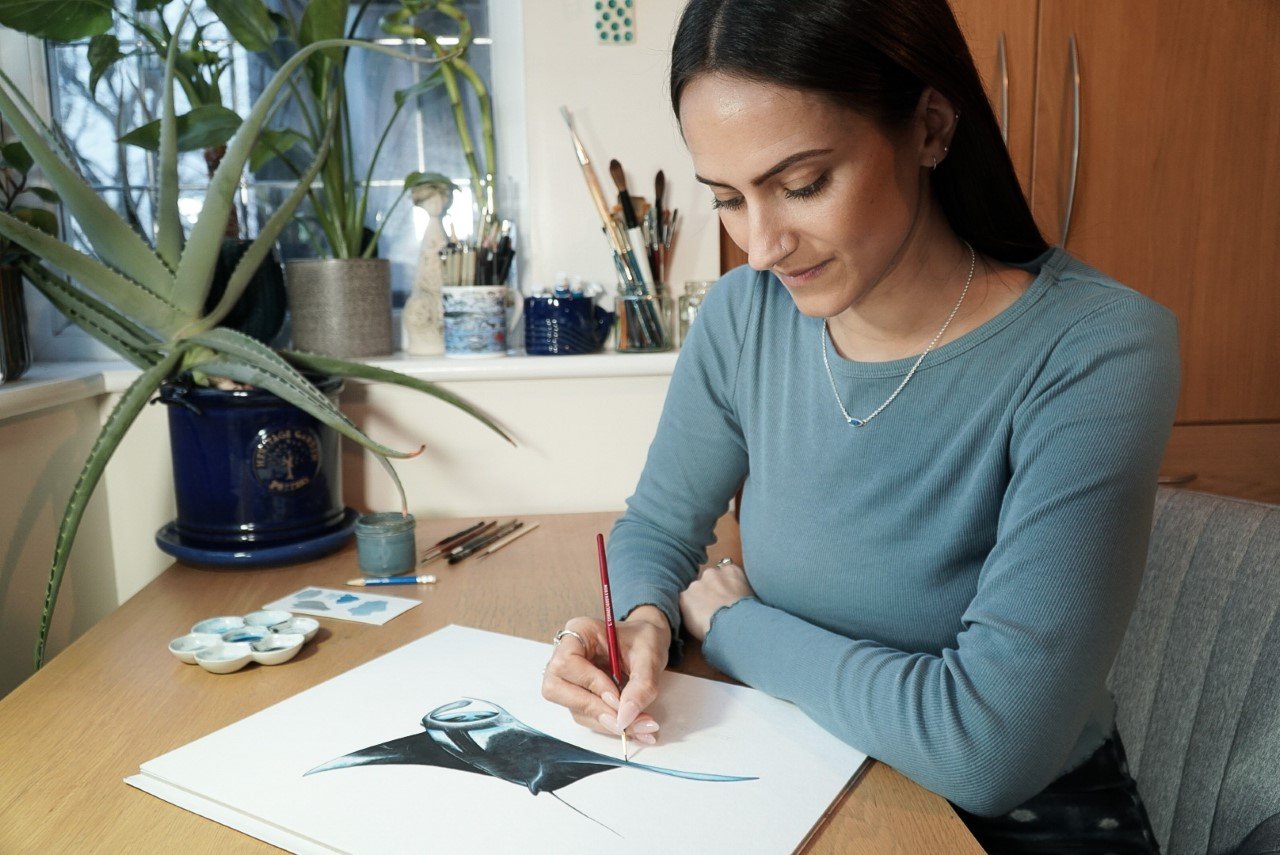An Artist’s Eye with Janavi Kramer
Josh Pysanczyn
Janavi Kramer is a British artist, conservation advocate and ocean explorer. Making the most out of a vibrant palette, Janavi’s illustrations would feel as at home on the wall of Picasso as they would on that of Jacque Cousteau. Through her artwork, Janavi not only seeks to illustrate the wonders of the ocean and capture some of the marine world’s most iconic creatures in their greatest light, but also hopes to stimulate discussions about the threats facing them.
All illustration credits: Janavi Kramer (Below and Beyond Art)
Hey Janavi! Tell us a bit about yourself and what you do
My name is Janavi Kramer and I’m a full-time artist, scientific illustrator and diver based in the UK. I have lived in the heart of Hertfordshire for most of my life but have always had an affinity for the natural world – in particular the ocean. Throughout my career I have worked in many different industries, but every path I took led me straight back to the ocean. Three years ago I decided to dive in and dedicate myself to marine conservation. Using art as my vessel my aim was to not only spread awareness of the threats impacting our oceans, but also showcase the endless beauty within it.
What role do you think art has in conservation of the natural world?
For hundreds of years art and science have formed an invaluable partnership that has given us a greater understanding of the natural world, making science and conservation accessible to all. Art is a universal language. It breaks down the barriers of conventional language, education - and even opportunity. You only have to look at greats such as Ernst Haeckel, Maria Sibylla Merian, and Leonardo da Vinci to appreciate this.
Throughout human history art has been an incredibly powerful yet underrated tool for communication: it holds a mirror up to the world we live in. I believe that in today’s society, with the ubiquitous use of visual-based social media platforms, this is all too easy to forget. That is why I have dedicated my career to sharing the knowledge I have gained about the ocean, in the hope that we can stretch our reach to those that are disconnected from the impending issues we face now. The importance of art creates an extra layer of emotional engagement that we need in order to encourage people to understand and actively become involved with conservation.
All illustration credits: Janavi Kramer (Below and Beyond Art)
What’s inspired you to merge your creativity with a passion for ocean conservation?
It was actually my love of diving that opened my eyes to this path; with all the wonders of the ocean I felt spellbound by its magic. But I also felt great frustration and sadness – with every awe inspiring experience came the brutal realisation that threats such as overfishing, climate change and plastic pollution are having a devastating impact on our oceans. We are living through a pivotal period where the natural world is being pushed past its breaking point. With my art, I hope to highlight these issues and inspire people to take action. Whether that is changing consumption behaviours, reducing plastic use or even becoming an ocean advocate. At the very least, I want my work to start a conversation and encourage people to care about the one thing we can’t live without - the ocean.
Who or what do you draw your creative influence from?
It goes without saying that my biggest inspiration comes from the ocean. As well as finding inspiration from other scientific illustrators and artists, I have been lucky enough to have the opportunity to dive all over the world. The ocean is filled with vibrant colours, textures and creatures in every shape and size and much of my work is born from trying to replicate these vivid memories and experiences.
Janavi is at home in the ocean, and draws her inspiration from it. Photo: Janavi Kramer.
Aside from your artwork, are there any other environmental awareness projects that you have been/are involved with?
When I am not creating artwork, I am immersing myself with hands-on conservation. For the last six years I have volunteered with various marine charities such as Marine Conservation Society and it is a really easy and simple way to contribute towards conservation! I assist with beach cleans, school events, and have even helped to create digital resources with them to reach wider audiences. For me, volunteering is not only an important way to learn more about environmental issues, but also a fantastic way to connect with others from all walks of life. I hope in the future that I can find more ways to collaborate with charities and support the invaluable work they do on the front-lines of conservation.
All illustration credits: Janavi Kramer (Below and Beyond Art)
All illustration credits: Janavi Kramer (Below and Beyond Art)
As an artist, you have access to a platform that a lot of us do not. How do you hope that this platform will allow you to influence the conservation of marine ecosystems?
I have always felt that within the 'ocean community' we take for granted what is ‘common knowledge’. One of the biggest discoveries that motivated my artistic and ocean advocating journey was the vast amount of people who are still disconnected from our ocean and the very real issues it faces. Whether this is the impact of food consumption and wastage, the effects of plastic pollution, or simply the vast array of species that live within marine environments. When you are immersed in the battle to save our oceans, it can be easy to feel overwhelmed with responsibility and frustration because we are painfully aware of how little time we have. But rather than projecting this fear onto others, my approach is to try and create art that sparks curiosity and conversation. A quote that I often refer to is:
"In the end we will conserve only what we love; we will love only what we understand; and we will understand only what we are taught." (Baba Dioum, 1968.)
I believe wholeheartedly that my role is to share knowledge that will inspire others to care, because it is only when people care that they will take action. Part of the responsibility associated with this is endeavouring to ensure that the educational information, resources and knowledge is accessible to anyone and everyone viewing my work.
All illustration credits: Janavi Kramer (Below and Beyond Art)
All illustration credits: Janavi Kramer (Below and Beyond Art)
What is the most rewarding aspect of your work?
For me, it has to be the simple things. Someone telling me that they have discovered or learned something from my work, or that they have decided to make a change as a result of something I created. These simple gestures or acknowledgments fill me with gratitude and make me realise that no matter how small or simple, we are capable of change. One thing that everyone within the conservation community knows is that good things take time. We are all in it for the long-run, no matter how long it takes! So these little symbols of change along the way make it all feel worth-while and keep the fire within me alive and burning strong.
All illustration credits: Janavi Kramer (Below and Beyond Art)
All illustration credits: Janavi Kramer (Below and Beyond Art)
Are there any upcoming projects that you can tell us about?
To those who know me, it's no secret that my favourite species is the manta ray. After my first encounter with one in Indonesia six years ago, it became the first oceanic creature to steal my heart. Since then, I have been fascinated by Mobulids (manta and devil rays). To me they are the most majestic, elegant and intelligent creatures in the ocean. Sadly, due to human impact we find ourselves in a world where all ten species in this genus are categorised as vulnerable or endangered. To imagine a world without them, a world where they exist only in the archives and history books, is not only heart breaking but would be a great loss to the marine ecosystem. That is why this year I will be launching a project that is specifically focused on these magnificent species and aims to give viewers an insight into the threats they are facing and raise funds for charities such as the Manta Trust to support their invaluable work.
I can't share too much about it just yet but if you love Manta Rays – follow along!
All illustration credits: Janavi Kramer (Below and Beyond Art)
Finally, is there any advice that you give to people who want to both explore the natural world and their creative talents?
As Jacques Yves Cousteau would say “We must go and see for ourselves”. As a creative, it is important to know and understand your subject and the best way to do that is to find a way to immerse yourself within it. For me, that takes shape in diving, but you can do so in many ways, whether that be volunteering, research or simply putting yourself out there and exploring!
I would urge anyone to reflect on the skills and talents they have and find a way to transform it into a conservation tool – you don't have to be an artist or a scientist to contribute towards conservation. The journey can be arduous, but if you continue to devote time to your practice, you will see the impact that you alone can have and inspire others too!
“You don’t have to be an artist or scientist to contribute to conservation”. For Janavi, immersing oneself in the natural world is the best way to understand it.
If you’ve enjoyed this interview with Janavi Kramer, you can follow her on Instagram, LinkedIn and Facebook. Check out her website too!
Want to be interviewed for us? Check out our ‘Get Involved’ section
Into the Industry delves into the daily lives of marine professionals, from aquarists to researchers, campaigners to eco-artists… and hear their top tips on how to get into the marine industry.
If you’ve enjoyed reading this interview look out for more Into the Industry, Seas the Day and Behind the Lens blogs from Josh Pysanczyn. Check out his blog and follow him here @wild_____life.













